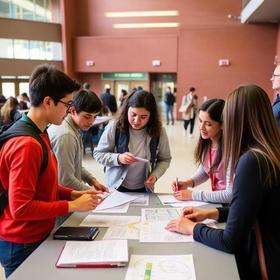- WyoTech's history began in June 1966 when 22 students from Wyoming and surrounding states started their careers in Automotive Technology in Laramie, Wyoming. Since then, WyoTech has graduated over 26,000 students from across the nation and several foreign countries. This WyoTech Blairsville campus received its initial accreditation in October 2001 and has received approval from 48 state governing authorities. WyoTech has maintained a policy of constantly upgrading facilities and courses to meet growing demands of the automotive, diesel, and collision/refinishing industries. Blairsville is a close-knit community of approximately 4,000 citizens nestled in the Conemaugh River Valley with the Conemaugh River forming 180 degrees of the town's perimeter border. Blairsville is rich in history as one of the vital transportation links between Philadelphia and Pittsburgh that facilitated the settling of this great nation in it's infancy. Throughout its history, WyoTech has kept its instructors abreast of the latest techniques, added new equipment as needed, and updated curriculum as changes occurred in the industry. "Moving into the Future" is not simply a slogan at WyoTech, it is a commitment.
School Highlights
Wyo Tech-Blairsville served 906 students (100% of students were full-time).
The college's student-teacher ratio of 18:1 was higher than the state community college average of 15:1.
Minority enrollment was 22% of the student body (majority Black), which was less than the state average of 48%.
School Overview
Wyo Tech-Blairsville
(PA) Community College Avg.
Carnegie Classification
Item not available
Not applicable, not in Carnegie universe (not accredited or nondegree-granting)
Institution Level
Less than 2 yrs
At least 2 but less than 4 years
Institution Control
Private, for profit
Private not-for-profit
Total Faculty
50 staff
59 staff
Number of Programs Offered
3
29
Student Body
Total Enrollment
906 students
461 students
Student-Teacher Ratio
18:1
15:1
# Full-Time Students
906 students
325 students
# Part-Time Students
n/a
136 students
# Enrollment Undergraduate
221 students
298 students
# Full-Time Undergraduate Students
906 students
326 students
# Full-Time Graduate Students
n/a
10 students
# Part-Time Undergraduate Students
n/a
151 students
# Part-Time Graduate Students
n/a
12 students
Total Dormitory Capacity
n/a
330 students
% Asian
n/a
5%
% Hispanic
4%
11%
% Black
9%
15%
% White
78%
52%
% Hawaiian
n/a
3%
% Two or more races
2%
3%
% Non Resident races
n/a
1%
% Unknown races
7%
10%
Diversity Score
0.38
0.68
College Completion Rate (Students who graduate in less than 4 years)
75%
59%
College Completion Rate (Students who graduate in 4 years or more than 4 years)
n/a
36%
Average Graduate Earnings (10 Years)
$45,400
$34,900
Tuition and Acceptance Rate
% Students Receiving Some Financial Aid
91%
94%
Median Debt for Graduates
$11,599
$12,696
Median Debt for Dropouts
$4,750
$5,500
Acceptance Rate
100%
84%
SAT Reading
n/a
460
SAT Math
n/a
470
SAT Writing
n/a
435
ACT Composite
n/a
20
ACT English
n/a
20
ACT Math
n/a
21
ACT Writing
n/a
7
Source: 2020 (or latest year available) Integrated Postsecondary Education Data System (IPEDS)
Frequently Asked Questions
What is the acceptance rate of Wyo Tech-Blairsville?
The acceptance rate of Wyo Tech-Blairsville is 100%, which is higher than the state average of 84%.
Recent Articles

Community College Success Rates 2025: Outcomes & Trends
Updated 2025 analysis of community college success rates, completion, transfer, costs, enrollment, and strategies that shape student outcomes.

Community Colleges in 2025: Combating Stereotypes with Impact
Updated insights on how community colleges are dispelling myths, growing enrollment, and expanding pathways in 2025.

2025 FAFSA Changes Explained for Community College Students
A comprehensive guide to 2025 FAFSA changes, what community college students must know, new eligibility rules, timelines, and tips to maximize federal aid.







